When humans first started burning fossil fuels on an industrial scale in the late 19th century, Earth’s atmosphere contained about 280ppm of CO2. The intervening years have seen that concentration rise above 410ppm, alongside a corresponding global average temperature increase of more than 1°C. There is virtually blanket scientific consensus that atmospheric CO2 is the root cause of this rapid warming, and that humanity must stop burning fossil fuels to halt it. Recently, however, there has also been growing consensus that decarbonisation on its own will not be enough.
If the goals set out in the 2016 Paris Agreement are to be met, many scientists – including those at the Intergovernmental Panel on Climate Change (IPCC) – believe that CO2 must be actively removed from the atmosphere. There are numerous ways this might be achieved using quasi-natural methods such as large-scale reforestation, rock weathering, and instigating massive ocean algae blooms that act as carbon sinks. Less natural – but no less interesting – is the method of direct air capture (DAC), whereby CO2 is extracted from the atmosphere using man-made technology.
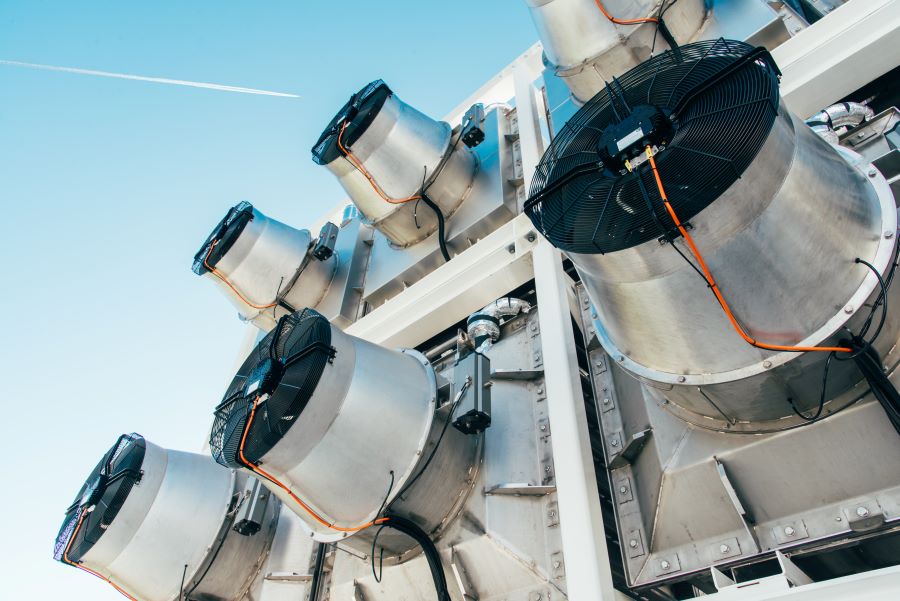
DAC has seen a handful of companies making waves over the past decade, including Canada’s Carbon Engineering, the US’s Global Thermostat and Climeworks of Switzerland. Broadly speaking, they rely on similar technologies, using amine-based sorbents to scrub CO2 from the air. The sorbents are then heated to release pure CO2 which can either be sequestered or repurposed for a variety of industrial and agricultural applications.
Climeworks’ DAC technology is based on a cyclic capture-regeneration process using a filter made of porous granulates modified with amines. Fans suck in atmospheric CO2 that chemically binds to the filter’s surface. Once saturated, the filter is then heated to around 100°C, releasing high-purity gaseous CO2. According to Climeworks, the filters can operate for several thousand cycles before needing to be replaced. Like most other DAC operators, the Swiss company relies on a source of waste heat to maximise the efficiency of its release process.
“We need energy to power our CO2 collectors,” Louise Charles, communications manager at Climeworks, told The Engineer. “We use only waste energy and renewable energy for this.”
The company’s first commercial plant in Hinwil, near Zurich, captures around 900 tonnes of CO2 per year using 2,000kWh of heat and around 600kWh of electricity per tonne. This is a drop in the ocean of total global emissions, but other plants have been coming online and Climeworks has ambitious plans of capturing 1 per cent of annual CO2 emissions by 2025.
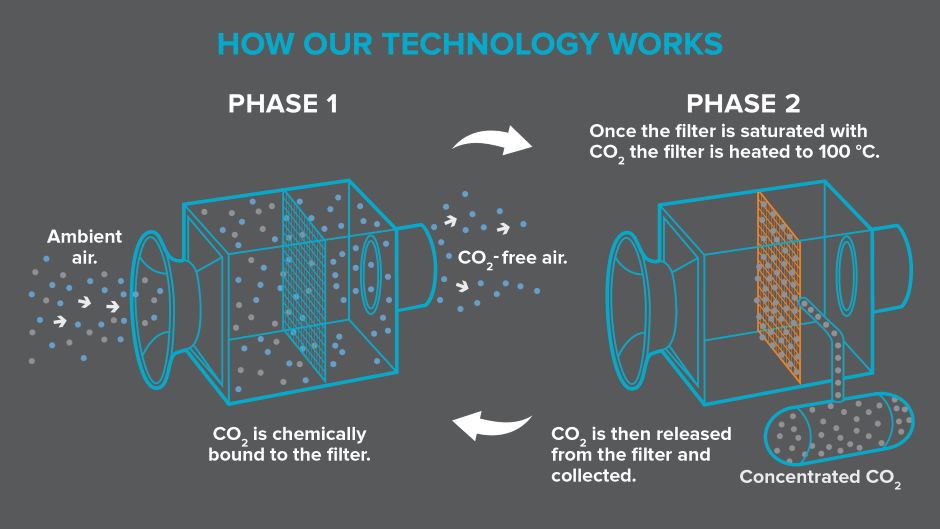
“The world currently emits 40 gigatons of CO2 every year – this is 12,688 tonnes per second,” Charles continued. “To capture 1 per cent of that would require 250,000 (Climeworks) plants, equivalent to 750,000 shipping containers full of collectors. This might sound like a lot – but in comparison, this is the same number of shipping containers that pass through Shanghai harbour in two weeks. This is something that the global economy can handle.”
While the global economy may well be able to handle it, it remains to be seen if it will be incentivised to fund it. Climeworks is currently capturing CO2 at $600-$800 (£474-£633) per tonne. Some of this cost is offset by selling the purified gas to customers in the beverage industry and for use in greenhouses to promote plant growth. This falls a long way short of covering the costs of capture, however.
What’s more, much of the gas sold on to customers ends up back in the atmosphere, diminishing the overall climate benefit.
“Removing CO2 from the atmosphere is a crucial condition to achieve climate goals: to hit the 2C target, we would have to remove 10 billion tonnes of CO2 every year from 2050 onwards”Louise Charles, Climeworks
In 2017, Climeworks teamed up with Iceland’s Reykjavik Energy on a pilot project to harness geothermal heat for its DAC process. The captured CO2 is then sequestered by pumping it 700m underground to react with the basalt bedrock, locking it away permanently in geological storage.
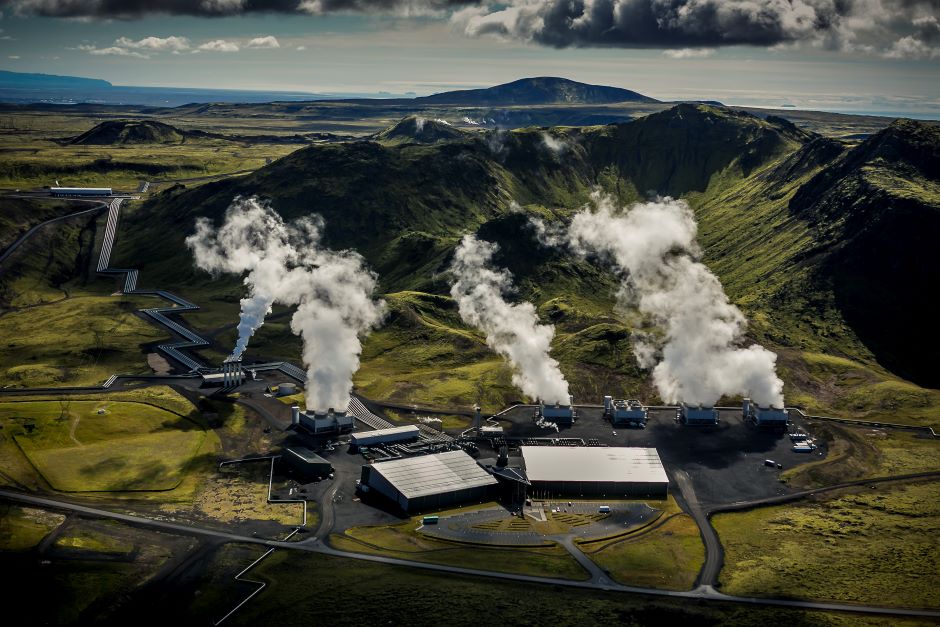
(Credit: Arni Saeberg)
Known as DACCS (direct air capture with carbon storage), this type of long-term sequestration is what will be required if humanity is to eventually reduce the concentration of atmospheric CO2back to 19th-century levels.
Locking away the CO2 means that there is no product to sell and, as a result, a substantial market for DACCS is yet to emerge. Carbon taxing could change this, as DACCS would allow organisations to offset unavoidable emissions, but the price of capture would still have to fall dramatically for DACCS to be commercially viable. According to Climeworks, a target of $100 per tonne is achievable and is also likely to intersect with carbon pricing in the near future.
“We have a clear cost-reduction road map for the future to bring down the cost of CO2 per tonne to $100,” said Charles. “Regulations that reflect the real cost of CO2 emissions need to be in place. We consider a price on carbon of $100-$150 per tonne by 2030 a realistic target.
“Removing CO2 from the atmosphere is a crucial condition to achieve climate goals: to hit the 2°C target, we would have to remove 10 billion tonnes of CO2 every year from 2050 onwards.”
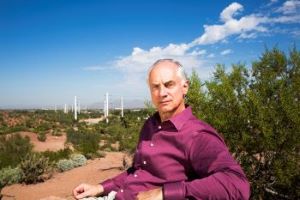
Climeworks may have a road map to $100, but there is a new start-up in the space that claims to already be there. Dublin-based Silicon Kingdom Holdings (SKH) says its ‘mechanical trees’, which passively capture CO2 using stacked discs of sorbent, will deliver DAC at $100 per tonne once at scale. The man behind the technology is Prof Klaus Lackner (left), director of Arizona State University’s (ASU) Center for Negative Carbon Emissions. Lackner, who will act as chief scientific adviser to SKH, is a pioneer in the DAC space, according to company CEO Pól Ó Móráin.
“If you look at Climeworks, Carbon Engineering, Global Thermostat – all those companies have actually based their start-ups and their technological approach on the early work of Klaus, and they’ll publicly acknowledge that,” Ó Móráin told The Engineer. “Klaus has been working on this going back to 1992 and in 1999 he was the first, globally, to say we need to take carbon out of the air to deal with climate change, and nobody listened for a long time.”
Four years ago, Lackner moved to ASU with a view to finally commercialising his decades of research. Other DAC companies were springing up all over the world, but Lackner anticipated that rushing to market would lead to a high cost of capture. It was better, he reasoned, to optimise the technology and deliver a system that could achieve $100 per tonne straight out of the blocks, leapfrogging any competitors that had enjoyed a head start. After Lackner crossed paths with venture capitalist Ó Móráin about a year ago, SKH was established in the latter’s native Ireland.
“Klaus’s focus was making it commercial, reducing the cost of capture and enhancing it, and looking at novel aspects in terms of design and the geometry,” said Ó Móráin. “So in some ways, he’s fallen behind where people are at in terms of roll-out and testing, but having taken that slower and more considered approach, he’s ended up with a design that’s very novel. It’s a shift to passive capture, so we don’t actually spend energy on the capture part.”
SKH’s column-shaped mechanical trees will use an ion-exchange material to harvest CO2 passively, without the need for fans or even the wind to draw air into them. The devices are 2.5m high when closed, but grow to around 10m when open, exposing 150 sorbent-filled discs, each with a diameter of about 1.5m. A cluster of 12 of these columns will be capable of capturing a tonne of CO2 per day, according to SKH
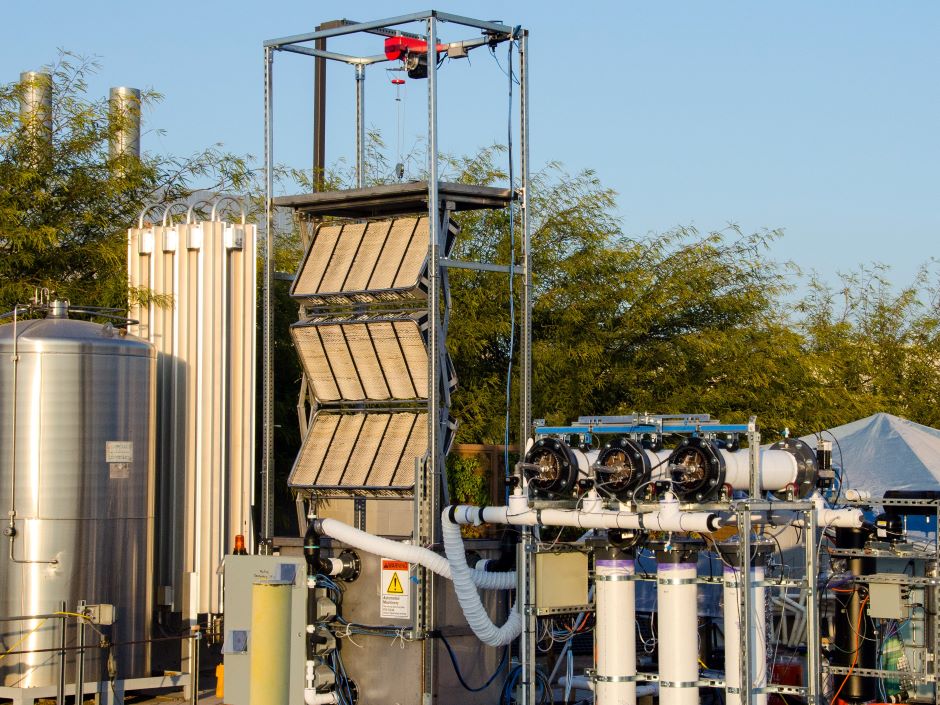
“Those discs are coated in an ion-exchange material, so they basically attract CO2 when they’re dry,” said Ó Móráin. “We’re not reliant on kinetic energy, so it’s not like a wind farm. It’s literally just the contact of air to the surface of the discs.”
After 20 minutes of exposure to air, the discs become saturated and return back into the base of the column, which is then sealed airtight. At this point, either heat or a change in humidity can be used to release the CO2, and the method can vary depending on local climate.
“We end up with 5 to 10 per cent (CO2) concentration at that stage on the offtake,” Ó Móráin explained. “If you want to get it up to 95 per cent for food grade or beverage grade, that’s a fairly standard process and our method would be no different to what anyone else would use.”
Lackner’s prototype device has been put through its paces in Arizona’s harsh conditions for more than a year, with no degradation of performance, according to Ó Móráin. The next stage will be a pilot project capable of capturing 100 metric tonnes a day. This will require around 1,200 of the mechanical trees, with a footprint roughly equivalent to 200 standard 40ft shipping containers. SKH is looking at locations in Arizona and California but is yet to make a final decision.
“We’re taking a gamble that the price of carbon is going to go to $100 per tonne. We don’t want to be a white elephant, so our focus is to build something profitable”Pól Ó Móráin, Silicon Kingdom Holdings
As with Climeworks, the question of economics looms large for SKH. Currently, the biggest market for CO2 is the energy industry, where it is used for a process called enhanced oil recovery (EOR). This involves pumping the gas into wells to extract crude oil that would otherwise be unobtainable.
Harvesting atmospheric CO2 to extract oil seems a counterintuitive way to mitigate climate change, and Climeworks has said it will not supply CO2 for this purpose. Ó Móráin, formally of BP, has a different view. He believes the EOR revenue stream is necessary to support DAC in its nascent stages and that the inevitable introduction of carbon pricing will ultimately allow the technology to fulfil a climate-friendly role.
“We don’t think the environmental market is there just yet,” the SKH CEO said. “We’re basically taking a gamble that the price of carbon is going to go to $100 per tonne.
“We don’t want to be a white elephant, so our focus is to build something now that’s profitable. We can satisfy the actual use cases of CO2 while the market prepares and flips for the more environmental capture and dispose.”
While EOR may divide opinion, synthetic fuel is an area that virtually everyone in the DAC space is embracing. Captured CO2 can be combined with other chemicals to create fuels that are theoretically carbon neutral, so long as the process is powered by waste heat and renewable energy. The end product is pricey in comparison with fossil fuels but could allow industries such as aviation and shipping to decarbonise in the absence of realistic pathways to electrification.
“The industrial sector and the transport sector will need in the future some chemical energy carriers. It will not be possible to do everything with electricity directly,” said Prof Roland Dittmeyer of Germany’s Karlsruhe Institute of Technology.
Dittmeyer and colleagues recently published a paper in Nature Communications outlining how air conditioning units could be used for DAC in buildings around the world, with the captured CO2 then processed locally into synthetic fuels.
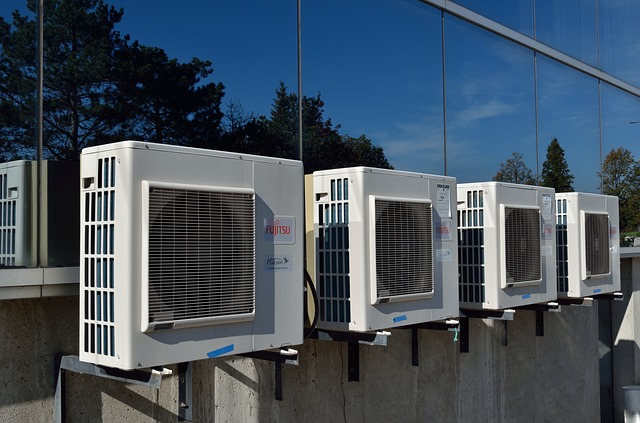
The ‘crowd oil’ produced by this decentralised capture and refining could then be used to power local transport or fed into a ‘renewable oil grid’. It could even act as a long-term storage medium with the option of utilising it at some point in the future.
“Taking air, conceptually, leads to a circular approach,” Dittmeyer told The Engineer. “You take the CO2 from the air, put in renewable energy – or CO2-free power, I should say, because it could also be nuclear – and then you generate a hydrocarbon which releases the CO2 again during use.
“Why combine it with ventilation systems? Because there you already contact a huge amount of air. You pay already for the electricity for making this contact. So if you can put this together, you eliminate one of the disadvantages of direct air capture. That was my motivation.”
Dittmeyer’s paper describes three potential scenarios for the technology: the Frankfurt Fair Tower office building, a typical supermarket and a collection of low-energy houses.
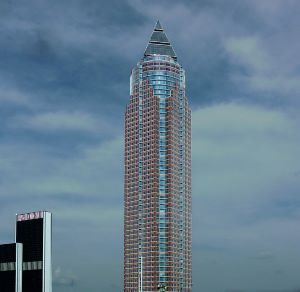
As one of the EU’s tallest skyscrapers, the Frankfurt Fair Tower (right, image credit: moritz320 via Pixabay) has a HVAC system that contacts huge volumes of air, and the research claims enough CO2 could be harvested there to produce 2,000-4,000 metric tonnes of synthetic fuel per year. If applied to all large office buildings across Germany’s five biggest cities, 2.4-4.8 million metric tonnes of synthetic fuel could be produced.
“You have to sacrifice probably one or two floors of a skyscraper for this kind of technology,” Dittmeyer explained. “The way that I would say is state-of-the-art is that you produce hydrogen. So you need an electrolyser. There are several companies offering this, typically in a modular format or container-based plants. It could be in the basement or on top, where you already have the big ventilation machines.”
At least two further reactor stages are required; one to convert the hydrogen and CO2 into a reactive gas, or syngas, and a second to convert that syngas into a hydrocarbon. Ineratec, a spin-out from the Karlsruhe Institute of Technology, has already developed container-based plants capable of the conversion process, and Dittmeyer believes these could be slotted into existing large buildings.
“A household air conditioner, quite evidently, that’s not the target here,” he said. “But say a large ventilation plant, in my opinion, can be retrofitted with these conversion steps.”
Questions remain about storage and transport. Large stockpiles of fuel within tall buildings or supermarkets pose an obvious risk, as would transferring it to roadside tankers. Dittmeyer is involved with a pilot project that’s currently producing 10 litres of synthetic fuel a day and there are plans to scale this up significantly over the coming years, with Climeworks one potential partner.
Within five to 10 years, the professor believes that the technology could be commercialised and play a key role in the climate battle.
“I hope that we see many of these systems in practice,” said Dittmeyer. “Because we have to do that. We have to achieve that, because time is running out.”











Comment: The UK is closer to deindustrialisation than reindustrialisation
"..have been years in the making" and are embedded in the actors - thus making it difficult for UK industry to move on and develop and apply...